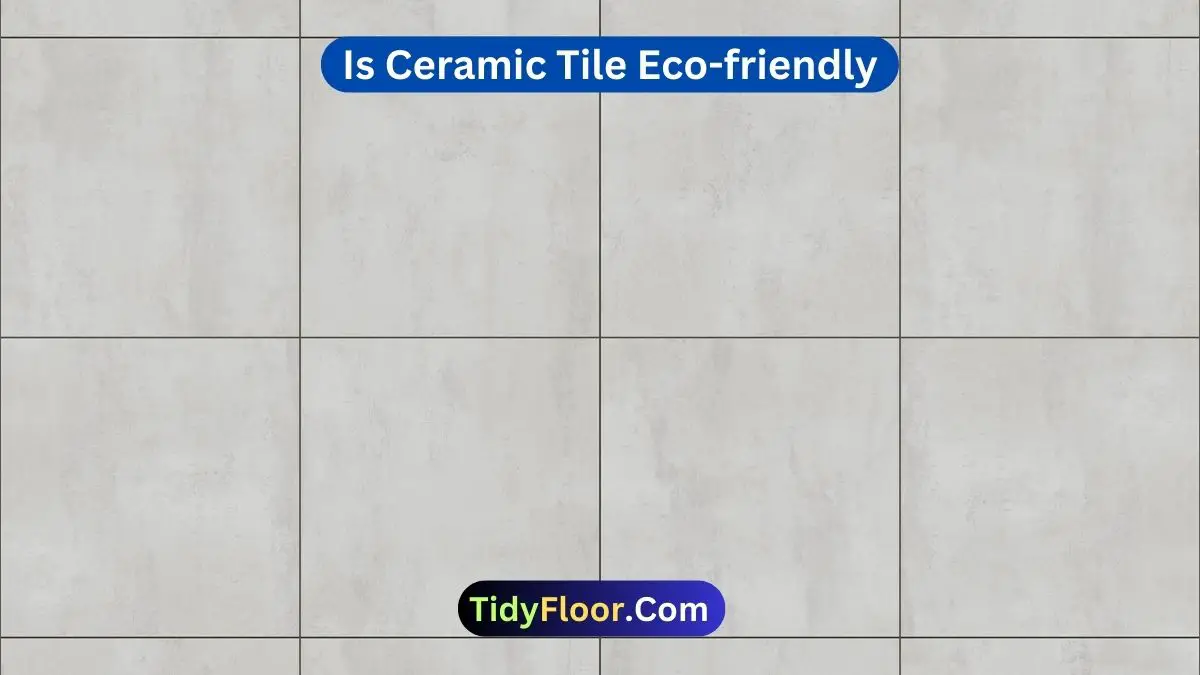Ceramic tiles are versatile and popular building materials known for their durability, aesthetic appeal, and functionality. Crafted from natural materials such as clay, sand, and minerals, ceramic tiles undergo a firing process to achieve their characteristic hardness and resilience. But the question arises is ceramic tile eco-friendly?
Ceramic tiles emerged as a compelling eco-friendly option for construction and design projects. Their composition of natural materials, durability, recyclability, low VOC emissions, and energy-efficient production processes make them a sustainable choice.
Throughout this article, I’ll discuss the reasons behind the ceramic tiles’ eco-friendliness and how installation affects the eco-friendliness.
9 Reasons Why Is Ceramic Tile Eco-Friendly:

Ceramic tiles offer just that—durable, stylish, and environmentally friendly. Let’s dive into why ceramic tiles are the perfect choice for green living.
#1- Natural Materials:
Ceramic tiles are primarily made from natural materials such as clay, sand, and other minerals. These materials are abundant in nature and are sourced sustainably, reducing the environmental impact associated with extraction.
#2- Durability:
One of the most significant eco-friendly attributes of ceramic tiles is their durability. They are highly resistant to wear, scratches, and stains, making them ideal for high-traffic areas in residential and commercial spaces. The long lifespan of ceramic tiles means they do not need frequent replacement, thereby reducing the consumption of resources and the generation of waste over time.
#3- Recyclability:
Ceramic tiles are recyclable at the end of their life cycle. While not all recycling facilities may accept them, there are initiatives and programs in place to collect and recycle ceramic tiles. Recycling ceramic tiles reduces the demand for raw materials and minimizes the amount of waste sent to landfills.
#4- Low VOC Emissions:
Volatile Organic Compounds (VOCs) are chemicals that can off-gas from building materials and negatively impact indoor air quality. Many ceramic tiles are manufactured using low-VOC processes and glazes, reducing the emission of harmful chemicals into the environment and promoting healthier indoor air quality.
#5- Energy Efficiency:
Modern ceramic tile manufacturing processes have become increasingly energy-efficient. Manufacturers employ advanced technologies and practices to reduce energy consumption during production, such as optimizing kiln firing processes and using recycled materials in production.
#6- Natural Cooling:
Ceramic tiles have high thermal mass, which means they can absorb and store heat during the day and release it slowly at night. This natural cooling effect can help regulate indoor temperatures, reducing the need for mechanical cooling systems and lowering energy consumption.
#7- Easy Maintenance:
Ceramic tiles are easy to clean and maintain, typically requiring only water or mild cleaning solutions. Unlike other flooring materials that may require harsh chemical cleaners, ceramic tiles contribute to a healthier indoor environment by minimizing exposure to harmful chemicals.
#8- Resistance to Allergens:
Ceramic tiles do not harbor allergens such as dust mites, mold, or pet dander, making them a suitable choice for individuals with allergies or respiratory sensitivities. This contributes to a cleaner and healthier indoor environment.
#9- Local Production:
Choosing locally manufactured ceramic tiles can further reduce environmental impact by minimizing transportation emissions associated with shipping products long distances. Supporting local manufacturers also helps sustain local economies and communities.
7 Mistakes That Destroy Ceramic Tiles’ Eco-Friendliness When Installing:
During ceramic tile installation, certain mistakes can inadvertently undermine their eco-friendliness. These errors can compromise the sustainability of the entire project.
1- Improper Adhesive Selection:
Choosing adhesives with high VOC content can contribute to indoor air pollution. Opt for low-VOC or VOC-free adhesives to maintain indoor air quality.
2- Excessive Waste:
Wasteful cutting or excessive breakage during installation can lead to unnecessary material consumption and increased waste. Careful planning and precise measurements can minimize waste.
3- Poor Sealing:
Inadequate sealing of grout lines can lead to water infiltration and mold growth, requiring remediation with potentially harmful chemicals.
4- Using Non eco-friendly Grout:
Some grout products contain additives that are harmful to the environment. Look for eco-friendly grout options that minimize environmental impact.
5- Improper Disposal of Waste:
Discarding leftover tiles, packaging materials, or other construction waste in landfills contributes to environmental pollution. Recycle or repurpose materials whenever possible.
6- Overuse of Cleaning Chemicals:
Harsh cleaning chemicals can harm the environment and indoor air quality. Opt for eco-friendly cleaning solutions to maintain ceramic tile surfaces without compromising environmental health.
7- Lack of Proper Maintenance:
Neglecting regular maintenance can lead to premature deterioration of ceramic tiles, necessitating replacement, and increased resource consumption.
Related Questions
Do Ceramic Tiles Contribute To Indoor Air Pollution?
Ceramic tiles themselves do not contribute to indoor air pollution as they are inert and do not emit volatile organic compounds (VOCs). However, certain adhesives, sealants, or grouts used during installation may contain VOCs which can off-gas into the indoor environment.
To minimize this risk, it’s essential to choose low-VOC or VOC-free products and ensure proper ventilation during installation. Once installed, ceramic tiles contribute to better indoor air quality by resisting allergens and being easy to clean.
Can Ceramic Tiles Be Recycled Or Repurposed?
Ceramic tiles can be recycled or repurposed at the end of their lifespan. While not all recycling facilities may accept them, there are initiatives and programs in place to collect and recycle ceramic tiles.
Repurposing options include using old tiles for mosaic art projects, outdoor pathways, or even as drainage material. Recycling ceramic tiles reduces the demand for raw materials and minimizes the amount of waste sent to landfills, contributing to a more sustainable approach to waste management.
Are There Any Drawbacks To Choosing Ceramic Tiles Over Other Flooring Options?
Though ceramic tiles offer durability and eco-friendliness, there are drawbacks. They can be cold underfoot, making them less comfortable in colder climates. Installation may require professional expertise. In addition, ceramic tiles may chip or crack under heavy impact. The grout lines between tiles may also accumulate dirt and require regular cleaning.
The hardness of ceramic tiles can be uncomfortable for long periods of standing. Despite these drawbacks, proper installation, regular maintenance, and area-specific considerations can mitigate these issues, making ceramic tiles a versatile and durable flooring option.
Are There Any Certifications To Look For When Purchasing Eco-friendly Ceramic Tiles?
Several certifications can indicate eco-friendly ceramic tiles. Look for products certified by organizations such as the Forest Stewardship Council (FSC), which ensures sustainable sourcing of wood used in tile packaging. The Ceramic Tile Distributors Association (CTDA) offers the “Green Squared” certification, verifying products’ environmental performance across various criteria.
Further, certifications like LEED (Leadership in Energy and Environmental Design) provide guidelines for sustainable building practices, including tile selection. These certifications assure consumers of a product’s adherence to eco-friendly standards.
Conclusion
Ceramic tiles stand out as an environmentally friendly choice, thanks to their natural composition, recyclability, and low environmental impact. However, ensuring their eco-friendliness relies on proper installation and maintenance practices. Assuming these principles underscores ceramic tiles’ role in sustainable construction and design without repeating information previously discussed. Hope, you got the answer is ceramic tile eco-friendly or not.


